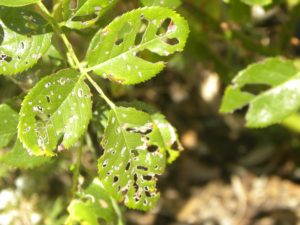A Reluctant Gardener Gets Educated
When Indian summer ends it’s not just time for me to plant veggies and bulbs; it’s also a good time to reflect on what I’ve learned from hanging out with real gardeners. If my plants were human, they would be uprooting themselves with laughter. Despite my knowledge, they haven’t noticed any improvement. I follow the Darwinian theory of survival of the fittest. Any plant surviving my manic attention followed by long periods of being ignored is allowed to remain in the garden. They don’t even have to look good. My rose garden sports bushes with lacey leaves. Their veins lend the leaves the look of hand-made lace — or hand-chewed lace. Even if I don’t practice all I’ve been taught, I have accrued a great deal of potentially useful information.
One very important thing I’ve learned is that many imported plants do not benefit our gardens. Having an English garden filled with roses, stock, delphiniums, and foxglove around a neatly manicured lawn means over-using our decreasing water supply. Eucalyptus trees, brought from Australia, are actually detrimental to our area: they are shallow rooted but grow to enormous sizes. They respond to drought by closing off their sap supply to one limb. You may hear a loud crack (like a rifle’s report) and the limb your tree just shed has flattened its landing pad. The city’s tree in front of our house dropped an enormous limb one night breaking glass, an umbrella pole and literally crushing part of our balcony’s solid railing. In addition, eucalyptus burn hotly in a wild fire. Its leaves and bark shed, creating more fuel. The soil beneath a eucalyptus becomes oily. Eventually water floats on the surface without penetrating. We replaced all of our soil about 30 years ago, but I’ve noticed that it’s oily again. (No, I don’t put additives and mulch in the garden. Someday we’ll pay someone to amend our soil properly.) Ficus benjamina is another tree to avoid planting in a yard. Once established, these ficus make hazardous walking as their shallow roots can cover a back yard with uneven surfaces. Date palms, prolific as rabbits, burn well and for a long time.
Vinca, a pretty blue-flowered vine, is a great groundcover. Sadly, it spreads easily into our canyons where they take over other native plants. Horse tail, fun to use in flower arrangements, is another invasive plant. I’m beginning to think watsonia may be invasive as well. The bulbs reproduce until your small patch is enormous.
I have also learned to love bees. Because I enjoy arranging flowers, I try to have year-round. Bees don’t care what plants look like and they don’t mind aphids or snails. They only care about gathering nectar. They seem to sense that I am not a threat; we co-exist in the garden peacefully.
We need bees to pollenate plants, and while the bees seem to be recovering from their plague that caused myriad bee deaths, they are very sensitive to pesticides. Even spraying nicotine to discourage insects from devouring your plants is very dangerous to bees. It causes them to lose their bearings so they cannot find their way back to the hive. We had one very agitated bee that joined us for dinner. I suspect she/he may have partaken of nicotine. It was dusk, and he just kept buzzing in circles. Our normal bees are much calmer.
I have learned appreciate succulents. As water becomes a more and more expensive commodity, we will be forced to abandon lush landscapes for plants that appreciate drought. I have killed many a succulent with water.
The San Diego Horticultural Society is another great teacher. I recently read in their newsletter an article by Tim Clancy, an arborist. He says “lacing” is NOT an arborist’s term. It is popularly considered to be a method of “thinning” a tree’s inner branches to allow the structure of the remaining branches to show. In fact, the article went on to say that severe pruning of inner branches may weaken a tree and causing premature death. Clancy explains that stripping the inner branches can interfere with “branch taper” because these branches help protect the limbs from being torn off by high winds. “Lacing” strips foliage needed for photosynthesis which in turn, may harm the root system. Clancy likes to remind people that trees only grow enough foliage for their needs; they do not grow leaves as an insurance policy. That’s another lesson learned by a reluctant gardener.
The Garden Club and its gardeners and speakers have opened my eyes to how each of our actions may have an effect on our world. From recycling to keeping toxins out of our sewers, to trying to consume less and re-use more, we are bound together, like it or not. We do not live in a vacuum; no one does. Even our economics are tied to the rest of the world. We need to do whatever we can so our children and grandchildren may thrive.
Category: Life Style








